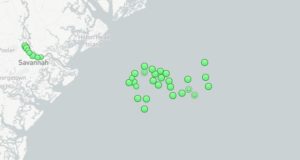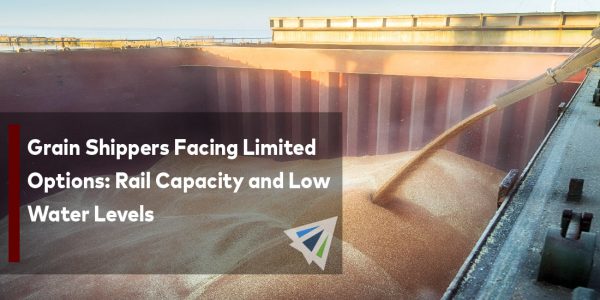Competitive Edge
November 23rd, 2022
UPDATE: U.S. and Canada Ports – Number of Cargo Vessels at Anchor
• Vancouver: 30 Vessels at Anchor (-7)
• Savannah: 27 Vessels at Anchor (-3)
• Houston: 8 Vessels at Anchor (-6)
• San Francisco/Oakland: 7 Vessels at Anchor (-1)
• Los Angeles/Long Beach: 4 Vessels at Anchor (-3)
• Mobile: 6 Vessels at Anchor (+2)
• New York/Newark: 2 Vessels at Anchor (-1)
• Charleston: 2 Vessels at Anchor (+2)
Note: Count taken on November 22, 2022. This count does not include vessels moored and being unloaded at port docks. Colored numbers in parentheses represents the change from last week over. Data is courtesy of MarineTraffic’s live vessel traffic map.
Have another U.S. or Canadian port you’d like us to track weekly? Let us know!
Takeaways
• U.S. West Coast: If the WC was a person, shippers would view is as a 10 for looks (vessel congestion) and then a 5 for personality (rail service, dwell times, and labor tensions). Despite ports, like Long Beach, making efforts to reassure that the WC is capable, anxious shippers continue to avert it in favor for the EC and GC.
• U.S. Gulf Coast: As we suspected, less marine traffic has piled up outside Houston. This week marked a newfound low for the Gulf’s largest port and the first time its vessel count plunged into single digits over the past several months.
Meanwhile, labor-related tensions have hit Mobile and could impact its vessel traffic. The Gulf Coast port is currently negotiating around strike action taken yesterday by its longshore workers. Specifically. Mobile’s breakbulk dockworkers are looking to secure a new contract with the port. They have not had a formal contract since 2018.
• U.S. East Coast: New York – once floating near Savannah with its backlog just a few months ago- has now tied Charleston as one of the least congested gateways in the U.S. with New York’s vessel count minimal, Savannah now more than ever sticks out like a sore thumb along the coastline. 27 vessels – nearly 13 times as many as New York – are strewn offshore.

Among all the U.S. ports above, Savannah is the only port with a count above single digits. While it’s seen a slight week-over-week drop, the Georgian port has a lot of headwind to face to make a sizeable cut to its congestion. Courtesy of MarineTraffic.
• Canada: Vancouver saw seven vessels eliminated week-over-week, but the port’s congestion remains punctuated with 30 ships to its backlog. With berthing delays continuing to plague Canada’s premier gateway, it’s uncertain to use right now on when Vancouver will observe sustained progress to its sizeable backlog.
IMPORT: Asia to North America (TPEB)
Recent Developments:
• Contract negotiations between the International Longshore and Warehouse Union (ILWU) and Pacific Maritime Association (PMA) remain active. The existing labor contract between the two parties expired July 1.
• Rail congestion is considerable at most ports, including inland hubs.
- Los Angeles, Long Beach, and Houston remain at the forefront for dwell times – still hovering around 14-20 days.
Rates: Near pre-pandemic rate levels have slightly fallen again. Speculation remains on when or if we will hit a post-pandemic floor with ocean freight and what rates will settle as. In addition, carriers have announced GRIs, effective November 15, affecting all U.S., and Canadian destinations. Of course, these typical general increases will bring added costs to ocean freight rates.
Space: Space is open.
Capacity: Carriers have reduced their capacities to balance the market amid low demand. Capacity remains generally open for transpacific trade.
Equipment: Chassis availability is in a crunch in pockets, but with production amping up and lower import volumes coming through, there is hope of relief. Congested rail ramps remain a frequent fixture.
TIPS:
• Book at least two weeks prior to the ready date.
• For cargo ready now, take advantage of open space and softened rates on the spot market.
• Blank sailings are in play which may affect schedule integrity.
IMPORT: Europe to North America (TAWB)
Recent Developments:
• Labor-related tensions are still stirring in the U.K. as the country’s largest port, Felixstowe, remains without a deal between unions and port employers. Further strike action is possible. However, the two parties have been actively negotiating.
Please watch our recent webinar for a closer look at the U.K.’s current labor tensions. We were joined by our British partners and discussed the impacts in greater detail.
Rates: While capacity has been added and demand has stayed relatively low, rates have not observed a dramatic drop – only slight decreases.
Space: Space to both U.S. coasts have opened up from the introductions of more vessels in October and November to the TWAB lane.
Capacity: Capacity has increased.
Equipment: Equipment availability at European seaports is still in a crunch. Inland terminals in Europe are also still reporting equipment shortages.
TIPS:
• Book at least four weeks prior to ready date.
• Stay up to date with your forwarder and carrier with advisories on added capacities and declining rates for the trade lane.
• Strongly consider premium services for no-roll options and improved reliability of cargo.
EXPORT: North America to Asia
Recent Developments:
• Savannah’s congestion remains a lead contributor to operational woes at the Georgian port.
• Schedule reliability, or lack thereof, remains an anxiety for exporters. In particular, Oakland saw its volumes dwindle in September as a result.
Rates: So far, no GRIs announced for December.
Capacity: Capacity remains stable.
Equipment: Inland ports, notably Kansas City and Memphis, are reporting container and chassis deficits (the latter improving). Standard equipment at ports remains available unless advised otherwise.
TIPS:
• Book at least four weeks prior to the time of departure to secure necessary equipment and vessel space.
InterlogUSA Proudly Presents...

Offering insights into breaking news, market trends, our company’s history, and more.
“FreightFM” features short-form video interviews with InterlogUSA’s industry experts.
What Thanksgiving Dishes Do Americans List as Their Favorites?
Turkey 83%
Mashed Potatoes 78%
Stuffing 77%
Rolls 74%
Sweet Potatoes or Yams 65%
Cranberry Sauce 52%
Freight News
Proposed Legislation for Port Investments and Additional Railway Safety Measures in Canada
In an effort to modernize the way Canada’s marine and rail transportation systems work and to amend current legislation, the Canadian Minister of Transport is seeking legislation for port investments and more railway safety measures.
The legislation, called, The Strengthening the Port System and Railway Safety in Canada Act, was introduced in the House of Commons – as announced in a news release last Thursday.
Some of the proposed amendments for ports include:
- Port competitiveness
- Governance and financial management of Canada port authorities
- Working with communities and Indigenous groups
- Environmental sustainability of port infrastructure and operations
- Port safety and security
Some of the proposed amendments for railways include:
- Enhanced transparency and collaboration
- Create a more efficient rail network
- Modernized oversight of railway operations
You can read more about these proposed amendments, here.
Declines Continue as Trans-Pacific Volume Continues to Plunge in October
Well, the Trans-Pacific lane continues to see rapidly low volume levels. Specifically, for the month of October, Asian imports totaled 1.44 million twenty-foot equivalent unites (TEUs) – which is down 11% from October of last year, data from the Journal of Commerce shows.
Part of this has to do with an atypical peak season this year. Usually, October is the last month of traditional peak season for the Trans-Pacific lane. But since inventory for retailers was a big issue in 2021, many of those retailers started early this year to make sure those same issues would not occur for a second year. As well as wanting to avoid the current congestion and labor issues out on the USWC.
Some optimism through, as Asian imports for the first ten months of this year (January through October) remain higher than 2021. As the JOC reports, volumes were up 2.4% compared to the same time frame as last year. Additionally, October 2022 imports were up only 2% from October 2019 which many feel shows a slight signal that demand could be returning to pre-pandemic levels.
Additionally, the Port of Oakland saw full imports and full exports rise in October compared to September, which is some good news for the ports. In October this year, the port handled nearly 80,000 TEUs (79,459), compared to 77,803 TEUs in September this year, data from the American Journal of Transportation reports.
Missed Last Weeks Webinar? Watch Here Now!
Sign Up for Next Month's Webinar
Our next webinar will be on Wednesday, December 21st – Time: TBD
Additionally, stay tuned for the announcement of
who our next special guests will be!
Finally, we would like to hear from you!
If you have any questions or topics you would like our experts
to discuss in future webinars, please let us know!
You can email us at sales@interlogusa.com
Interlog  Insights
Insights
Last week we wrapped up our Interlog Insights for November. For November, we discusssed the current rail union labor agreement talks, what a new normal for the logistics industry means, how Canada is trying to modernize and improve the way their ports work, and more.
Sign up for our Interlog Insights newsletter for weekly insights from our experts. We will discuss what currently is happening in the industry, as well as our experts sharing their thoughts on what we may see in the future.
Sign up for our
industry answers
Our team works to provide valuable, unique, and relevant content to assist you in finding solutions. Sign up now.

